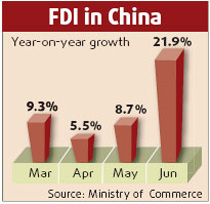Traditional Chinese medicine, a 5,000-year-old science, has gone high-tech with a revolutionary computerized diagnosis system.
Wang Yiqin, a 30-year veteran of TCM research, is leading a team to electronically translate TCM code to the world.
Wang's research has led to the development of electronic equipment which follows the four-step TCM diagnostic method including inspection (wang), olfaction (wen), inquiry (wen) and pulse (qie).
Wang, a professor at the Shanghai University of Traditional Chinese Medicine, said the technology would release TCM wisdom to the world.
"Our vision is to accurately translate the language of TCM and make it understandable and reliable to not only Chinese but foreigners," Wang said.
The system, called computerized tongue and pulse diagnostic tools, can tell patients whether they are ill in minutes, based on a computer, sensors, a re-designed question and answer list and database analysis software.
As shown at an industry fair recently, the diagnosis machine, through its sensors, can measure people's pulses in the Chinese traditional way.
It then sends the pulse's frequency and vibration to a laptop computer for analysis. The machine determines whether vital organs (wuzang) are working normally, such as heart, kidney and liver (TCM's definition of organ is slightly different to the Western definition). People get a printed result showing several pulse lines and what they represent.
"TCM doctors can use them to compare patient conditions before and after the treatment and they can use detailed figures to prove the effect of treatment," Wang said.
TCM depends on the observation and experience of its practitioners. Its theory, include qi and yinyang, seems strange to foreign doctors.
But, aided with the computer diagnostic technology, TCM can be partially be translated as a quantitative classification of condition.
The technology is likely to lead to an increase in worldwide popularity of TCM, according to Wang.
Wang, however, said TCM can't be 100 percent "translated" and the equipment can't detect all kinds of diseases such as hypertension.
The analysis software's database, the core of the TCM machine, was established with the involvement of more than 10 experienced doctors, such as cardiologist Yan Dexin, digestive expert Ma Guitong and neurologist Yuan Canxing.
The results of the project, which is financed by the government, are expected to be displayed during World Expo 2010 in Shanghai.
Though the equipment is at the laboratory stage, there is great commercial potential, Wang said.
During the industry fair, visitors queued at the booth to attend the new-type test.
"It is impressive as the doctor is not an old man with gray hair. Instead, she is a young lady with a laptop," said one of the visitors. "I hope I can have one at home one day."
Shanghai Asia & Pacific Computer Information System Co has cooperated with Wang's team to make the equipment commercially viable.
Some TCM research organizations and hospitals have already adopted the systems, according to the IT developer of the system.
Initially, small or community hospitals will use the system.
Further down the road, the TCM diagnostic systems will be used in big hospitals nationwide and they will have smaller models for families to use at home, according to Wang.
The Shanghai Health Bureau started trials of TCM in neighborhoods in 1999 and started to spread the service across the city last year.
TCM services now cover all downtown centers and 97 percent of clinics on the outskirts, officials said.
To promote the service and improve its quality, authorities named 32 model TCM service centers in each district and Chongming County to showcase good practices.
Nationally, 8,328 comprehensive hospitals will have a TCM service.
The TCM university has signed an agreement with Zhangjiang-based Green Valley Holding to cooperate and industrialize the equipment.
(Shanghai Daily January 4, 2008)


